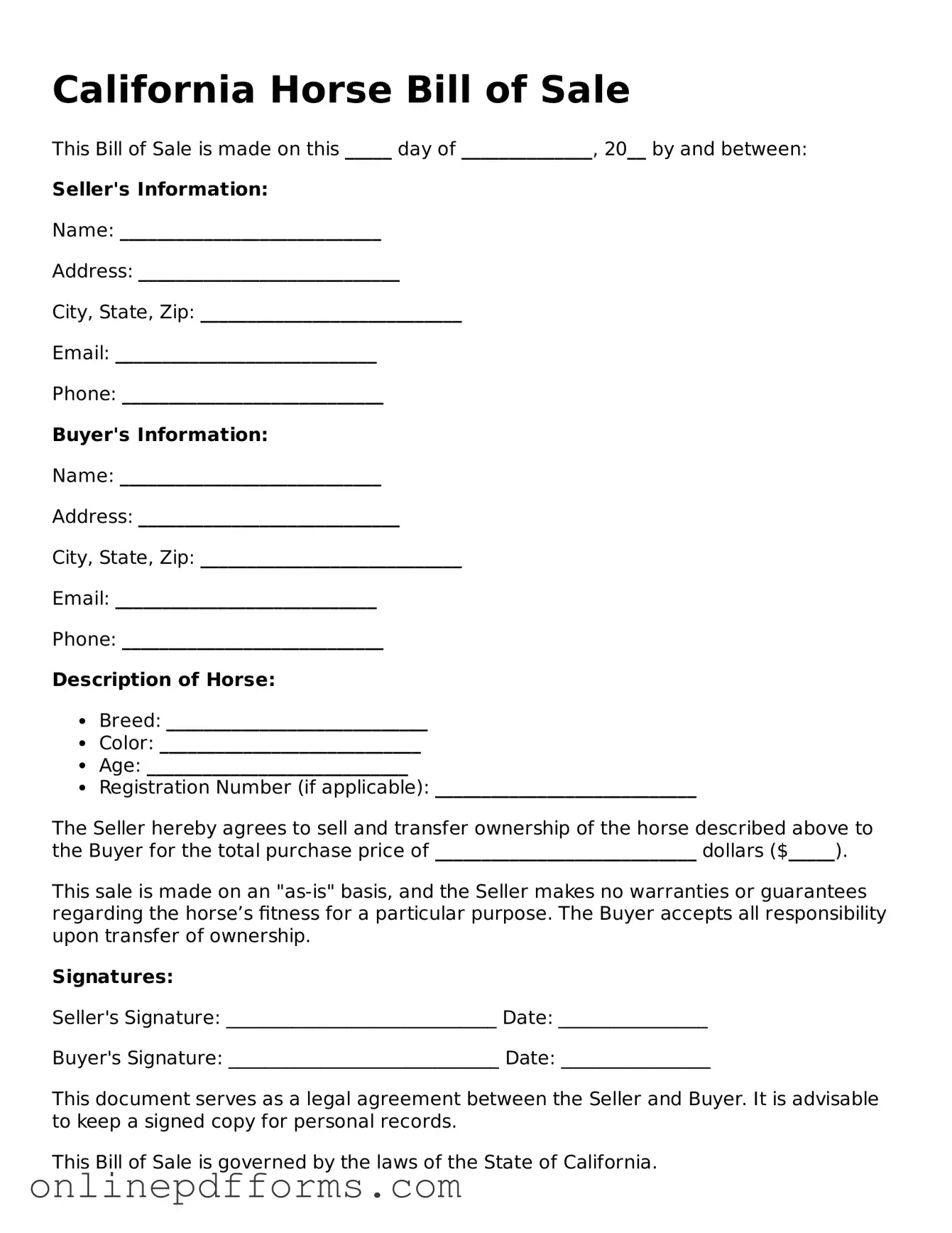The California Horse Bill of Sale form shares similarities with the Vehicle Bill of Sale, which is used to document the sale of motor vehicles. Both documents serve as proof of transfer of ownership from the seller to the buyer. They typically include essential details such as the names and addresses of both parties, a description of the item being sold, and the purchase price. Just as the Horse Bill of Sale provides a record of the horse's identification and health status, the Vehicle Bill of Sale often requires the vehicle's identification number (VIN) and odometer reading to ensure transparency in the transaction.
Another document akin to the Horse Bill of Sale is the Boat Bill of Sale. This form is utilized when a watercraft is sold, and like the Horse Bill of Sale, it establishes a legal record of ownership transfer. Both documents require detailed descriptions of the item, including make, model, and year. Furthermore, they often necessitate the inclusion of any warranties or guarantees provided by the seller, ensuring that the buyer is fully informed about the condition of the item at the time of sale.
The Pet Bill of Sale is also comparable to the Horse Bill of Sale, as it facilitates the transfer of ownership of pets, including dogs and cats. Both documents emphasize the importance of identifying the animal being sold, often requiring details such as breed, age, and health records. Additionally, they serve to protect the rights of both the buyer and seller by documenting the agreed-upon terms of the sale, including any conditions or restrictions related to the animal's care and ownership.
Similarly, the Equipment Bill of Sale is relevant in transactions involving heavy machinery or agricultural equipment. This document, like the Horse Bill of Sale, outlines the specifics of the equipment being sold, including its condition and any warranties. Both forms aim to provide clarity and security for both parties, ensuring that the buyer understands what they are purchasing and that the seller is protected from future claims regarding the sale.
The Firearm Bill of Sale also shares common elements with the Horse Bill of Sale. This document records the transfer of ownership of firearms and includes pertinent details such as the make, model, and serial number of the weapon. Just as the Horse Bill of Sale may require health certifications for the horse, the Firearm Bill of Sale often mandates compliance with local and federal regulations, ensuring that the transaction adheres to legal standards and safeguards public safety.
The Livestock Bill of Sale is another document that mirrors the Horse Bill of Sale, particularly in agricultural contexts. This form is used to document the sale of livestock, including cattle, sheep, and pigs. Both documents require detailed descriptions of the animals being sold, often including identification numbers and health records. They serve to protect the interests of both the buyer and seller, ensuring that all relevant information is disclosed and agreed upon at the time of sale.
The Real Estate Purchase Agreement, while more complex, shares the foundational purpose of documenting a transfer of ownership. Both documents outline the terms of the sale, including the parties involved, the item being sold, and the agreed-upon price. While the Real Estate Purchase Agreement delves into property specifics, such as legal descriptions and contingencies, the Horse Bill of Sale focuses on the horse's identification and health, yet both aim to provide legal protection and clarity in the transaction.
The Personal Property Bill of Sale is another document that aligns with the Horse Bill of Sale. This general form is used for various personal items, ranging from furniture to electronics. Similar to the Horse Bill of Sale, it includes details about the item being sold, the parties involved, and the purchase price. Both documents serve as legal proof of ownership transfer, ensuring that buyers have clear documentation of their purchase while protecting sellers from future claims.
When dealing with various types of sales, ensuring that you have proper documentation is essential. For those selling or purchasing vehicles, you can find useful resources such as Vehicle Bill of Sale Forms that help facilitate a seamless transaction, ensuring all necessary information is clearly detailed and legally binding.
Lastly, the Business Asset Bill of Sale is relevant in transactions involving the sale of business-related assets. This document outlines the specifics of the assets being sold, which may include equipment, inventory, or even intellectual property. Like the Horse Bill of Sale, it provides a clear record of the transfer of ownership and includes details about the condition and value of the assets. Both documents are essential for ensuring transparency and legal compliance in their respective transactions.
